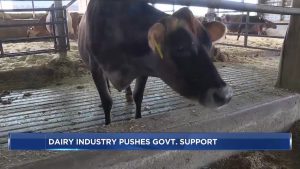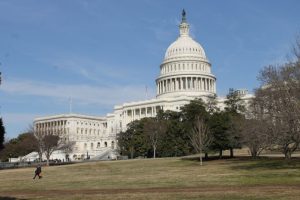
And Thanksgiving was just the first act.
The holidays bring forth Christmas and Hanukkah cookies, holiday pies, casseroles, mashed potatoes and turkeys.
That means it’s primetime for butter — a staple and essential ingredient across seasonal dinner tables and holiday parties.
Famed chef Julia Child’s famous quote “with enough butter, anything is good” has rung true with generations of chefs from Martha Stewart down to home cooks and bakers next door.
And just like so many other products, butter has seen a significant jump in prices as part of the inflation wave as well as some supply chain challenges still stemming from the various upheavals of the coronavirus pandemic as well as climate changes with warmer temperatures impacting U.S. milk production.
Milky way
Leonard Polzin, dairy markets and policy outreach specialist at the University of Wisconsin–Madison, said milk production was down during the first half of the year impacting supplies of dairy products — including butter.
“All the way through June we have year-over-year negative production,” Polzin said.
Warmer temperatures and droughts can impact dairy cows and agricultural outputs. Top dairy producing U.S. regions such as California, Wisconsin, Idaho and Texas faced warmer temperatures and heat waves that impacted dairy cows and other farm animals.
In June, a summer heat wave killed more than 2,000 cattle in Kansas, according to the state’s health and environment agency.
“On the production side, you are seeing different types of weather risks,” Polzin said.
“One of the large contributing factors to this event is drought. The west has been in a persistent drought and access to water is becoming a bigger deal all the time — especially for western herds,” Polzin continued, pointing to droughts and warmer temperatures in California, the Pacific Northwest and other regions.
Higher prices
All that — along with higher fuel and feed prices — is cutting into supplies and pushing up prices for dairy products.
Butter prices are up 26.7% compared to a year ago, according to the latest Consumer Price Index figures released last month. That includes 3.8% worth of price increases in September and October.
Margarine prices are up 47.1% from October 2021 with a 12.8% rise from August to October, according to the U.S. Bureau of Labor Statistics.
Prices are up across grocery store aisles and much of the rest of the economy. Overall, grocery prices are up 12.4% from a year ago, including for other cooking staples such as flour (24.6%), eggs (43%), milk (14.5%) and cheese (12.4%).
“The price of milk overall reached record levels earlier in the spring. That was driven a lot by constrained supply,” said Chris Galen, senior vice president of the National Milk Producers Foundation.
Wholesale milk prices are up more than 14% since the beginning of the year even with drops from summer highs, according to Trading Economics, an economic research firm.
Galen said the recent surge in butter prices that led up to the Thanksgiving holiday should ease a bit.
“They stocked up,” Gallen said of consumers who bought extra butter supplies just in case stores ran short on inventories. “Nobody wants to be out of a staple.”
He does not expect shortages at supermarkets even with some declines in cold storage inventories. “The price should be coming down,” he said.
Galen said higher feed and energy costs can discourage farmers from expanding their dairy and other herds.
Those higher costs — some of which have been magnified by U.S. and European sanctions on Russia and Belarus — have been felt throughout the agriculture sector, said John Hickman, director of Salisbury University’s Business Economic and Community Outreach Network on Maryland’s agriculture-heavy Eastern Shore.
“One of the big drivers of inflation has been those energy prices,” Hickman said. That includes a 17.5% year-over-year jump in gasoline prices and a 68.5% jump in fuel oil prices, according to BLS.
Lauren Poor, director of government affairs for the Oregon Farm Bureau, has continued to hear about concerns regarding butter prices and supplies in the lead up to the holiday season. She also worries about new state regulations related to the climate and emissions laws as well as new Oregon rules extending overtime pay to farm workers driving up costs for producers.
A number of major U.S. butter producers did not respond to requests for comment about inventories and higher prices.
Up with cheese
Some of the impacts of the pandemic and its economic shutdowns also continue to hit food supplies.
Polzin has seen producers put more supplies toward cheese production over other dairy products.
A study by European food packaging conglomerate Tetra Pak found that 36% of consumers globally upped their cheese consumption during the pandemic with only 6% reporting a decline.
There also continues to be increased cheese demand in countries such as China, India and Turkey as well as other Asian, Middle Eastern and African markets.
Polzin also has seen higher demand for cheese in the U.S. “Some of that is remnants of COVID,” he said.
The result is more milk supplies put toward cheese — and less toward butter. That includes larger commitments of milk produced in the midwest to cheese production, including increased exports.
‘Big confluence’
Polzin said food chains and prices are still not out of the woods, including for dairy products.
“There are so many changes happening at once right now,” he said.
That includes continued farming impacts of Russia’s war in Ukraine (and resulting U.S. sanctions) on grains, feed and fertilizers.
Domestically, potential railroad strikes and alarmingly low water levels in the Mississippi River could further disrupt supply and food chains.
“There is still a lot of risk out there from a lot of these events,” Polzin said. “There is just a big confluence of many factors at one time.”























